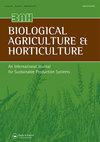北方气候条件下冬季覆盖作物的选择
IF 1.6
4区 农林科学
Q3 AGRONOMY
引用次数: 15
摘要
摘要覆盖作物在轮作中的使用提供了广泛的生态系统服务,包括保护土壤免受营养损失。这项研究的目的是确定冬季覆盖作物物种是否适合爱沙尼亚的条件。2016年至2018年期间,爱沙尼亚作物研究所对覆盖作物品种冬黑麦(Secale cereale L)、冬芜菁油菜(Brassica rapa spp.oleifera L.)、饲料萝卜(Raphanus sativus L.var.longiphindus)、毛豌豆(Vicia villosa Roth)和三叶草(Trifolium alexandrinum L.)进行了田间试验。评价了生物量的产生、氮(N)、磷(P)、钾(K)、钙(Ca)和镁(Mg)的积累。在北欧条件下的研究结果表明,毛茛与冬黑麦和冬芜菁油菜一起越冬。到了春天,与其他物种相比,毛豌豆产生了最多的生物量,积累了最多的氮。冬油菜对磷、钾、钙的吸收量以春季最高。在这两个年份中,饲草萝卜在秋季表现出最高的生物量和养分积累。在春季越冬和分解后,饲料萝卜在地上留下洞,这可能是一个有益的特征,特别是在免耕农业系统中。Berseem三叶草在秋季没有产生显著的生物量,并被第一次霜冻杀死,因此被认为不适合作为北纬地区的越冬覆盖作物。本文章由计算机程序翻译,如有差异,请以英文原文为准。
Selecting winter cover crop species for northern climatic conditions
ABSTRACT The use of cover crops in crop rotations provides a wide range of ecosystem services including protection of the soil from nutrient loss. The objective of this study was to determine the suitability of winter cover crop species for Estonian conditions. Field trials with cover crop species winter rye (Secale cereale L), winter turnip rape (Brassica rapa spp. oleifera L.), forage radish (Raphanus sativus L. var. longipinnatus), hairy vetch (Vicia villosa Roth) and berseem clover (Trifolium alexandrinum L.) were carried out during the period 2016–2018 at the Estonian Crop Research Institute. Biomass production, nitrogen (N), phosphorous (P), potassium (K), calcium (Ca) and magnesium (Mg) accumulation were evaluated. The results under northern European conditions indicated that together with winter rye and winter turnip rape, hairy vetch survived the winters. By the spring, hairy vetch had produced the most biomass and accumulated the highest amount of N, compared with the other species. Winter turnip rape showed the greatest uptake of P, K and Ca in the spring. In both years, forage radish presented the highest biomass and nutrient accumulation in the autumn. After winterkill and decomposition in the spring, the forage radish left holes in the ground, which could be a beneficial characteristic, particularly in no-tillage farming systems. Berseem clover did not produce remarkable biomass in the autumn and was killed by the first frosts and was therefore considered unsuitable as an overwintering cover crop for northern latitudes.
求助全文
通过发布文献求助,成功后即可免费获取论文全文。
去求助
来源期刊
CiteScore
3.30
自引率
6.70%
发文量
18
审稿时长
>36 weeks
期刊介绍:
Biological Agriculture & Horticulture aims to act as the central focus for a wide range of studies into alternative systems of husbandry, and particularly the biological or organic approach to food production. The Journal publishes work of a sound scientific or economic nature related to any aspect of biological husbandry in agriculture, horticulture and forestry in both temperate and tropical conditions, including energy and water utilization, and environmental impact.

 求助内容:
求助内容: 应助结果提醒方式:
应助结果提醒方式:


